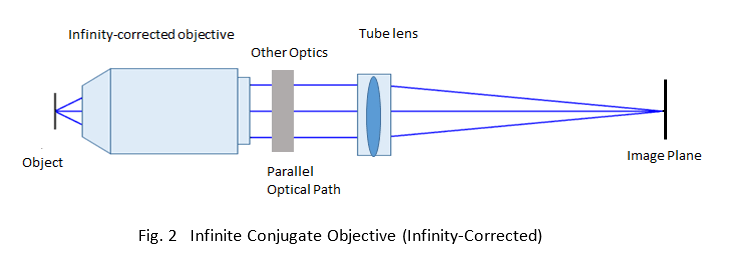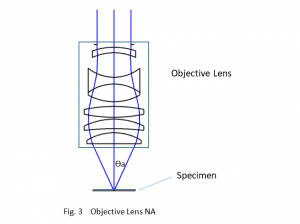Objective lenses are used in microscopy systems for a range of scientific research, industrial, and general lab applications. A microscope objective is typically composed of multiple lens elements and located closest to the object. There are so many types of microscope objectives available, choosing the right objective can help you produce good quality images at a reasonable cost.
When choosing a microscope objective, we will need to consider a number of factors including conjugate distance, numerical aperture (NA), magnification, working distance, immersion medium, cover glass thickness, and optical aberration corrections. In this article, we will discuss how to choose the right microscope objective.
Many objective lenses are corrected for infinite conjugate distance, while others are designed for finite conjugate distance applications. Compared to infinite conjugate objectives which need a secondary lens (also called tube lens), a finite conjugate objective can generate an image of a specimen by itself.
A finite conjugate objective, as shown in Figure 1, is a good, economical choice for a simple microscopy system.
Infinity-corrected objectives are ideal for research-grade biomedical industrial applications especially when additional components (such as filters, dichroic mirrors, polarizers) are needed in the microscopy system. Adding optical plate components in the infinity space (shown in the Fig.2 labelled as “Parallel Optical Path) between the infinity-corrected objective and tube lens will not introduce spherical aberration, or change the objective’s working distance.

The most important parameter of a microscope objective is the numerical aperture (NA). NA measures the microscope objective’s ability to gather light and determines the resolution of a microscopy system.

NA is commonly expressed as
NA = n × sinθa
where θa is the maximum 1/2 acceptance angle of the objective, and n is the index of refraction of the immersion medium.
The limit of resolution of a microscope objective refers to its ability to distinguish two closely spaced Airy disks.
Resolution (r) = λ/(2NA)
Where r is resolution (the smallest resolvable distance between two objects), and λ is the imaging wavelength. The higher the NA, the better the objective resolution.
Objective lenses are used to magnify an image. In addition to numerical aperture, magnification is also an important parameter. The objective magnification typically ranges from 4X to 100X. As the image sensor size or eye observed area is fixed, the field of view of a microscopy system changes with the magnification of the objective lens. Typically a lower magnification objective lens will have a larger field of view and lower resolution, and a higher magnification objective lens will have a smaller field of view and higher resolution.
The diameter of the FOV can be calculated by using the following formula:
FOV= FN/Mag
The field number (FN) in microscopy is defined as the diameter of the area in the image plane that can be observed through the eyepiece or image sensor.
Usually the working distance (WD) refers the distance from the front lens element of the objective to the observed object when the object is in sharp focus. Objective lenses with long working distance are needed for many scientific research applications such as atom trapping and analyzing fluid samples that require putting an object in a chamber.
The resolution of a microscopy system can be significantly affected if the observed object is not placed on the designed object plane, especially for an objective with high NA.
A dry objective is designed to work with the air medium between the specimen and the objective lens, while an immersion objective requires a liquid medium to occupy the space between the object and the front element of the objective for enabling a high NA and high resolution. Figure 4 shows the oil immersion objective, which can collect more light (i.e., have a higher NA) compared to a dry objective.
The most common immersion media are air, water, oil, and silicone. Choosing the appropriate objective designed for your immersion medium will result in higher resolution images.
The optical aberration corrections determine the optical performance of an objective lens. According to the degrees of the aberration corrections, objective lenses are typically classified into five basic types: Achromat, Plan Achromat, Plan Fluorite (Plan Semi-Apochromat), Plan Apochromat, and Super Apochromat. Choosing an objective with a proper aberration correction level will help you build a microscopy system at a reasonable cost.
SO offers a wide range of objective designs, which provide various degrees of optical aberration corrections for supporting different needs, such as achromatic objectives (the cheaper objectives) for laboratory microscope applications and long working distance apochromats (expensive objectives) for biological and scientific research applications. We can help you choose or design a properly corrected objective lens for meeting your application requirements.